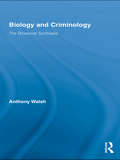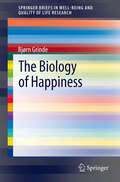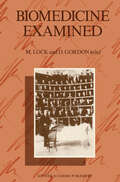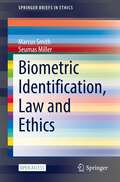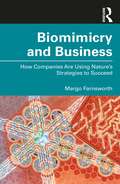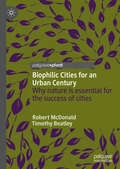- Table View
- List View
Biological Processes in Living Systems (Toward a Theoretical Biology)
by C. H. WaddingtonBiological Processes in Living Systems is the fourth and final volume of the Toward a Theoretical Biology series. It contains essays that deal in detail with particular biological processes: morphogenesis of pattern, the development of neuronal networks, evolutionary processes, and others. The main thrust of this volume brings relevance to the general underlying nature of living systems. Faced with trying to understand how the complexity of molecular microstates leads to the relative simplicity of phenome structures, Waddington-on behalf of his colleagues-stresses on the structure of language as a paradigm for a theory of general biology. This is language in an imperative mood: a set of symbols, organized by some form of generative grammar, making possible the conveyance of commands for action to produce effects on the surroundings of the emitting and the receiving entities. "Biology," he writes, "is concerned with algorithm and program." Among the contributions in this volume are: "The Riemann-Hugoniot Catastrophe and van der Waals Equation," David H. Fowler; "Differential Equations for the Heartbeat and Nerve Impulse," E. Christopher Zeeman; "Structuralism and Biology," Rene Thom; "The Concept of Positional Information and Pattern Formation," Lewis Wolpert; "Pattern Formation in Fibroblast Cultures," Tom Elsdale; "Form and Information," C. H. Waddington; "Organizational Principles for Theoretical Neurophysiology," Michael A. Arbib; "Stochastic Models of Neuroelectric Activity," Jack D. Cowan. Biological Processes in Living Systems is a pioneering volume by recognized leaders in an ever-growing field.
Biological Processes in Living Systems (Toward a Theoretical Biology)
by C. H. WaddingtonBiological Processes in Living Systems is the fourth and final volume of the Toward a Theoretical Biology series. It contains essays that deal in detail with particular biological processes: morphogenesis of pattern, the development of neuronal networks, evolutionary processes, and others. The main thrust of this volume brings relevance to the general underlying nature of living systems. Faced with trying to understand how the complexity of molecular microstates leads to the relative simplicity of phenome structures, Waddington-on behalf of his colleagues-stresses on the structure of language as a paradigm for a theory of general biology. This is language in an imperative mood: a set of symbols, organized by some form of generative grammar, making possible the conveyance of commands for action to produce effects on the surroundings of the emitting and the receiving entities. "Biology," he writes, "is concerned with algorithm and program." Among the contributions in this volume are: "The Riemann-Hugoniot Catastrophe and van der Waals Equation," David H. Fowler; "Differential Equations for the Heartbeat and Nerve Impulse," E. Christopher Zeeman; "Structuralism and Biology," Rene Thom; "The Concept of Positional Information and Pattern Formation," Lewis Wolpert; "Pattern Formation in Fibroblast Cultures," Tom Elsdale; "Form and Information," C. H. Waddington; "Organizational Principles for Theoretical Neurophysiology," Michael A. Arbib; "Stochastic Models of Neuroelectric Activity," Jack D. Cowan. Biological Processes in Living Systems is a pioneering volume by recognized leaders in an ever-growing field.
Biological-Psychosocial Interactions in Early Adolescence (Psychology Revivals)
by Richard M. Lerner Terryl T. FochFirst published in 1987, Biological-Psychosocial Interactions in Early Adolescence explores the mutually - influential relations between biological and psychosocial variables as the basis for development in the early portions of the adolescent period and, in fact, across the entire life span. The volume introduces key conceptual and methodological issues that are raised by the study of biological-psychosocial interrelations. It provides key foundations for the research conducted in major laboratories in USA back in 1980s. It also provides the results from these laboratories and their progress at that time. This book will be an essential read for scholars and researchers of psychology, behavioural science, and sociology.
Biological-Psychosocial Interactions in Early Adolescence (Psychology Revivals)
by Richard M. Lerner; Terryl T. FochFirst published in 1987, Biological-Psychosocial Interactions in Early Adolescence explores the mutually - influential relations between biological and psychosocial variables as the basis for development in the early portions of the adolescent period and, in fact, across the entire life span. The volume introduces key conceptual and methodological issues that are raised by the study of biological-psychosocial interrelations. It provides key foundations for the research conducted in major laboratories in USA back in 1980s. It also provides the results from these laboratories and their progress at that time. This book will be an essential read for scholars and researchers of psychology, behavioural science, and sociology.
The Biological Revolution: Applications of Cell Biology to Public Welfare
by Gerald WeissmannBasic biological research is not in trouble, but support for this cultural product is perhaps more fragile than it should be. We have developed, in this country, in Europe, and in Japan a triumphant record of research accomplishment that has rev olutionized our vision of the cell, the body, and the environ ment. The genetic code has been unraveled, the means of neuromuscular transmission have been elucidated, we know the fine detail of the cell's small geography, and we can de scribe the genes of mouse and man in chemical terms. But it is less clearly perceived by laity and scientist how this new revo lution in biology has been of use in the service of a better medicine or environment. The aim of this series of essays, which grew out of a symposium at the First International Congress of Cell Biology, is to instruct us all in the use that has been made of our new knowledge. In the fields of cancer, behavior, reproduction, genetic engineering, and environmental monitoring, practical results of our new knowledge are already apparent and more are just at hand. But neither the general public nor scientists working in their own narrow disciplines necessarily ap preciate these developments. Perhaps it is all just too new, too "experimental," to permit anyone to gain a proper perspective on what we have done or have the potential of doing.
Biology and Criminology: The Biosocial Synthesis (Routledge Advances in Criminology)
by Anthony WalshNumerous criminologists have noted their dissatisfaction with the state of criminology. The need for a new paradigm for the 21st century is clear. However, many distrust biology as a factor in studies of criminal behavior, whether because of limited exposure or because the orientation of criminology in general has a propensity to see it as racist, classist, or at least illiberal. This innovative new book by noted criminologist Anthony Walsh dispels such fears, examining how information from the biological sciences strengthens criminology work and both complements and improves upon traditional theories of criminal behavior. With its reasoned case for biological science as a fundamental tool of the criminologist, Walsh's groundbreaking work will be required reading for all students and faculty within the field of criminology.
Biology and Criminology: The Biosocial Synthesis (Routledge Advances in Criminology)
by Anthony WalshNumerous criminologists have noted their dissatisfaction with the state of criminology. The need for a new paradigm for the 21st century is clear. However, many distrust biology as a factor in studies of criminal behavior, whether because of limited exposure or because the orientation of criminology in general has a propensity to see it as racist, classist, or at least illiberal. This innovative new book by noted criminologist Anthony Walsh dispels such fears, examining how information from the biological sciences strengthens criminology work and both complements and improves upon traditional theories of criminal behavior. With its reasoned case for biological science as a fundamental tool of the criminologist, Walsh's groundbreaking work will be required reading for all students and faculty within the field of criminology.
The Biology of Happiness (SpringerBriefs in Well-Being and Quality of Life Research)
by Bjørn GrindeThe brief presents a model for happiness based on current knowledge in evolutionary biology and neurobiology. Briefly, the primary purpose of nervous systems is to direct an animal toward behaviour relevant for survival and procreation. In primitive animals actions are based on reflexes, while in humans the modules directing behaviour engage positive and negative affect (good and bad feelings), and they are swayed by cognitive processes. The reason why evolution opted for this strategy was the improved flexibility in response – i.e., we learn from previous experiences. The human capacity for happiness is an accidental consequence.An array of brain modules has evolved to care for various pursuits, but recent studies suggest that they converge on shared neural circuits designed to generate positive and negative mood. Happiness can be construed as the net output of the relevant modules. The briefs suggests a strategy for how to avoid having negative feelings (such as anxiety, depression and chronic pain) dominate the mind, and how to exercise positive feelings. In short, the book offers both a deeper understanding of what happiness is about, and a framework for improving well-being.An array of brain modules has evolved to care for various pursuits, but recent studies suggest that they converge on shared neural circuits designed to generate positive and negative mood. Happiness can be construed as the net output of the relevant modules. The book suggests a strategy for how to avoid having negative feelings (such as anxiety, depression and chronic pain) dominate the mind, and how to exercise positive feelings. In short, the book offers both a deeper understanding of what happiness is about, and a framework for improving well-being.
The Biomedical Empire: Lessons Learned from the COVID-19 Pandemic
by Barbara Katz RothmanWe are all citizens of the Biomedical Empire, though few of us know it, and even fewer understand the extent of its power. In this book, Barbara Katz Rothman clarifies that critiques of biopower and the "medical industrial complex" have not gone far enough, and asserts that the medical industry is nothing short of an imperial power. Factors as fundamental as one's citizenship and sex identity—drivers of our access to basic goods and services—rely on approval and legitimation by biomedicine. Moreover, a vast and powerful global market has risen up around the empire, making it one of the largest economic forces in the world. Katz Rothman shows that biomedicine has the key elements of an imperial power: economic leverage, the faith of its citizens, and governmental rule. She investigates the Western colonial underpinnings of the empire and its rapid intrusion into everyday life, focusing on the realms of birth and death. This provides her with a powerful vantage point from which to critically examine the current moment, when the COVID-19 pandemic has exposed the power structures of the empire in unprecedented ways while sparking the most visible resistance it has ever seen.
Biomedical Image Registration: 9th International Workshop, WBIR 2020, Portorož, Slovenia, December 1–2, 2020, Proceedings (Lecture Notes in Computer Science #12120)
by Žiga Špiclin Jamie McClelland Jan Kybic Orcun GokselThis book constitutes the refereed proceedings of the 9th International Workshop on Biomedical Image Registration, WBIR 2020, which was supposed to be held in Portorož, Slovenia, in June 2020. The conference was postponed until December 2020 due to the COVID-19 pandemic. The 16 full and poster papers included in this volume were carefully reviewed and selected from 22 submitted papers. The papers are organized in the following topical sections: Registration initialization and acceleration, interventional registration, landmark based registration, multi-channel registration, and sliding motion.
Biomedical Image Registration, Domain Generalisation and Out-of-Distribution Analysis: MICCAI 2021 Challenges: MIDOG 2021, MOOD 2021, and Learn2Reg 2021, Held in Conjunction with MICCAI 2021, Strasbourg, France, September 27–October 1, 2021, Proceedings (Lecture Notes in Computer Science #13166)
by Marc Aubreville David Zimmerer Mattias HeinrichThis book constitutes three challenges that were held in conjunction with the 24th International Conference on Medical Image Computing and Computer-Assisted Intervention, MICCAI 2021, which was planned to take place in Strasbourg, France but changed to an online event due to the COVID-19 pandemic. The peer-reviewed 18 long and 9 short papers included in this volume stem from the following three biomedical image analysis challenges: Mitosis Domain Generalization Challenge (MIDOG 2021), Medical Out-of-Distribution Analysis Challenge (MOOD 2021), and Learn2Reg (L2R 2021). The challenges share the need for developing and fairly evaluating algorithms that increase accuracy, reproducibility and efficiency of automated image analysis in clinically relevant applications.
The Biomedical Sciences in Society: An Interdisciplinary Analysis
by Iain CrinsonThis textbook provides a comprehensive introduction to the interdisciplinary field of the Social Studies of Science and Technology (SSST). Over the past two decades, the biomedical sciences have transformed our understanding of the relationship between the social and natural worlds, while its ‘promissory visions’ are seen to offer extraordinary opportunities for economic and social development. But alongside these scientific innovations have emerged new, and frequently unanticipated social, political, bioethical, and legal dilemmas and challenges. This cutting-edge text explores ‘post-genomic’ developments in the field of pharmacogenomics and the prospects for a new ‘precision’ or personalised medicine; the potential of environmental epigenetics to reconfigure the boundaries of the social and natural worlds; the emergence of an array of ‘neuro-disciplines’, seeking to identify the neural basis of a whole range of social and economic behaviours; and the challenges of constructing a coherent and robust governance framework for the conduct of biomedical science research and innovation, responsive to the social and health needs of the whole population.
Biomedical Translational Research: Technologies for Improving Healthcare
by R. C. Sobti Aastha SobtiThis book, which is the first volume of Biomedical Translational Research, summarizes emerging technologies in healthcare. The book reviews the advancements in biomedical sciences in genomics, immunology, stem cell, tissue engineering, nanotechnology, computational and structural biology, biomedical engineering, and telemedicine biology. The book highlights the applications of artificial intelligence in the diagnosis of infectious diseases and examines the role of system biology approaches for understanding human complexity, variability, and its influence on health and diseases. It presents the applications of flow cytometry in monitoring the progression and treatment of disease. It covers emerging technologies in cancer research, including CRISPR-Cas9, NGS, and nanotechnology. This book is a useful source of information for clinical researchers, basic scientists, biomedical engineers, and computational biologists.
Biomedicine Examined (Culture, Illness and Healing #13)
by M. Lock D. GordonThe culture of contemporary medicine is the object of investigation in this book; the meanings and values implicit in biomedical knowledge and practice and the social processes through which they are produced are examined through the use of specific case studies. The essays provide examples of how various facets of 20th century medicine, including edu cation, research, the creation of medical knowledge, the development and application of technology, and day to day medical practice, are per vaded by a value system characteristic of an industrial-capitalistic view of the world in which the idea that science represents an objective and value free body of knowledge is dominant. The authors of the essays are sociologists and anthropologists (in almost equal numbers); also included are papers by a social historian and by three physicians all of whom have steeped themselves in the social sci ences and humanities. This co-operative endeavor, which has necessi tated the breaking down of disciplinary barriers to some extent, is per haps indicative of a larger movement in the social sciences, one in which there is a searching for a middle ground between grand theory and attempts at universal explanations on the one hand, and the context-spe cific empiricism and relativistic accounts characteristic of many historical and anthropological analyses on the other.
Biometric Authentication: ECCV 2004 International Workshop, BioAW 2004, Prague, Czech Republic, May 15, 2004, Proceedings (Lecture Notes in Computer Science #3087)
by Davide Maltoni Anil K. JainBiometric Authentication: International ECCV 2002 Workshop Copenhagen, Denmark, June 1, 2002 Proceedings (Lecture Notes in Computer Science #2359)
by Massimo Tistarelli Josef Bigun Anil K. JainBiometric authentication refers to identifying an individual based on his or her distinguishing physiological and/or behavioral characteristics. It associates an individual with a previously determined identity based on that individual s appearance or behavior. Because many physiological or behavioral characteristics (biometric indicators) are distinctive to each person, biometric identifiers are inherently more reliable and more capable than knowledge-based (e.g., password) and token-based (e.g., a key) techniques in differentiating between an authorized person and a fraudulent impostor. For this reason, more and more organizations are looking to automated identity authentication systems to improve customer satisfaction, security, and operating efficiency as well as to save critical resources. Biometric authentication is a challenging pattern recognition problem; it involves more than just template matching. The intrinsic nature of biometric data must be carefully studied, analyzed, and its properties taken into account in developing suitable representation and matching algorithms. The intrinsic variability of data with time and environmental conditions, the social acceptability and invasiveness of acquisition devices, and the facility with which the data can be counterfeited must be considered in the choice of a biometric indicator for a given application. In order to deploy a biometric authentication system, one must consider its reliability, accuracy, applicability, and efficiency. Eventually, it may be necessary to combine several biometric indicators (multimodal-biometrics) to cope with the drawbacks of the individual biometric indicators.
Biometric Authentication: First International Conference, ICBA 2004, Hong Kong, China, July 15-17, 2004, Proceedings (Lecture Notes in Computer Science #3072)
by David Y. Zhang Anil K. JainBiometric Identification, Law and Ethics (SpringerBriefs in Ethics)
by Marcus Smith Seumas MillerThis book is open access. This book undertakes a multifaceted and integrated examination of biometric identification, including the current state of the technology, how it is being used, the key ethical issues, and the implications for law and regulation. The five chapters examine the main forms of contemporary biometrics–fingerprint recognition, facial recognition and DNA identification– as well the integration of biometric data with other forms of personal data, analyses key ethical concepts in play, including privacy, individual autonomy, collective responsibility, and joint ownership rights, and proposes a raft of principles to guide the regulation of biometrics in liberal democracies.Biometric identification technology is developing rapidly and being implemented more widely, along with other forms of information technology. As products, services and communication moves online, digital identity and security is becoming more important. Biometric identification facilitates this transition. Citizens now use biometrics to access a smartphone or obtain a passport; law enforcement agencies use biometrics in association with CCTV to identify a terrorist in a crowd, or identify a suspect via their fingerprints or DNA; and companies use biometrics to identify their customers and employees. In some cases the use of biometrics is governed by law, in others the technology has developed and been implemented so quickly that, perhaps because it has been viewed as a valuable security enhancement, laws regulating its use have often not been updated to reflect new applications. However, the technology associated with biometrics raises significant ethical problems, including in relation to individual privacy, ownership of biometric data, dual use and, more generally, as is illustrated by the increasing use of biometrics in authoritarian states such as China, the potential for unregulated biometrics to undermine fundamental principles of liberal democracy. Resolving these ethical problems is a vital step towards more effective regulation.
Biometrics in the New World: The Cloud, Mobile Technology and Pervasive Identity
by Julian AshbournThis book takes a fresh look at biometrics and identity management, extending the dialogue beyond technical considerations, and exploring some of the broader societal and philosophical aspects surrounding the use of biometric applications. Features: presents a brief history of the development of biometrics, and describes some of the popularly held misconceptions surrounding the technology; investigates the challenges and possibilities of biometrics across third party infrastructures and on mobile computing devices; provides guidance on biometric systems design; explores the mechanisms necessary to enable identity intelligence, including logging mechanisms, data communications and data formats; discusses such usage issues as collaboration frameworks, and messaging and data translation; examines the impact of biometric technologies on society, covering issues of privacy and user factors; reviews the current situation in identity management, and predicts where these trends may take us in the future.
Biomimicry and Business: How Companies Are Using Nature's Strategies to Succeed
by Margo FarnsworthBiomimicry, the practice of observing then mimicking nature’s strategies to solve business challenges, offers a path to healthy profit while working in partnership, and even reciprocity, with the natural world. Other books have described biomimicry, its uses, and its benefits. This book shows readers how to create their own biomimetic or bioinspired solutions with clear benefits to the bottom line, the environment, and people. Fashioned through storytelling, this book blends snapshots of five successful companies – Nike, Interface, Inc., PAX Scientific, Sharklet Technologies, and Encycle – which decided to partner with nature by deploying biomimicry. The book details how they discovered the practices, introduced them to staff, engaged in the process, and measured outcomes. The book concludes with challenges for readers to determine their own next steps in business and offers practical and useful resources to get there. By revealing the stories of each professional’s journey with lessons they learned, then providing resources and issuing a challenge and pathway to do business better, this book serves as a tool for entrepreneurs, seasoned professionals, and students to emulate nature’s brilliance, apply it at work, and contribute to a healthier, more prosperous world.
Biomimicry and Business: How Companies Are Using Nature's Strategies to Succeed
by Margo FarnsworthBiomimicry, the practice of observing then mimicking nature’s strategies to solve business challenges, offers a path to healthy profit while working in partnership, and even reciprocity, with the natural world. Other books have described biomimicry, its uses, and its benefits. This book shows readers how to create their own biomimetic or bioinspired solutions with clear benefits to the bottom line, the environment, and people. Fashioned through storytelling, this book blends snapshots of five successful companies – Nike, Interface, Inc., PAX Scientific, Sharklet Technologies, and Encycle – which decided to partner with nature by deploying biomimicry. The book details how they discovered the practices, introduced them to staff, engaged in the process, and measured outcomes. The book concludes with challenges for readers to determine their own next steps in business and offers practical and useful resources to get there. By revealing the stories of each professional’s journey with lessons they learned, then providing resources and issuing a challenge and pathway to do business better, this book serves as a tool for entrepreneurs, seasoned professionals, and students to emulate nature’s brilliance, apply it at work, and contribute to a healthier, more prosperous world.
Biophilic Cities for an Urban Century: Why nature is essential for the success of cities
by Robert McDonald Timothy BeatleyThis book argues that, paradoxically, at their moment of triumph and fastest growth, cities need nature more than ever. Only if our urban world is full of biophilic cities will the coming urban century truly succeed. Cities are quintessentially human, the perfect forum for interaction, and we are entering what could justly be called the urban century, the fastest period of urban growth in human history. Yet a growing body of scientific literature shows that the constant interaction, the hyper-connectedness, of cities leads to an urban psychological penalty. Nature in cities can be solution to this dilemma, allowing us to have all the benefits of our urban, connected world yet also have that urban home be a place where humanity can thrive. This book presents best practices and case studies from biophilic design, showing how cities around the world are beginning to incorporate nature into their urban fabric. It will be a valuable resource for scholars and professionals working in the area of sustainable cities.
A Biophilic Pattern Language for Cities: Creating Healthy Urban Environments (Sustainable Urban Futures)
by Phillip B. RoӧsThis book presents a holistic integral sustainable design and planning method embedded in the hypothesis of biophilia, our innate connection to nature, used as a platform to chart a biophilic pattern language framework. In A Biophilic Pattern Language for Cities, the author positioned the innate human-nature connection as critical in biophilic design and sustainable city planning solutions.
Biophilic Urbanism: Designing Resilient Communities for the Future
by Phillip James TabbBiophilic Urbanism provides readers with the tools to create more nature-based urban environments that are climate positive, sustainable, and healthy. The principles of biophilia are intended to support appreciation and direct engagement with nature, to responsibly utilize on-site natural resources, and to plan according to climatic conditions and local ecological processes. It seeks to create resilient and equitable human places capable of providing critical life-support functions and a strong sense of community, and to foster experiences that raise the human spirit creating a sense of awe. Twenty-five pattern attributes are defined and explored, each of which contributes to these goals. Because of the dire necessity to respond to the COVID-19 pandemic, Biophilic Urbanism includes discussion of our need for connections, both to nature and one another, and the physical characteristics of cities and buildings relative to the contagious qualities of the air-borne virus. Case studies, found throughout the world, are presented illustrating detailed biophilic planning and design strategies. The book will be of use to practitioners and students in the fields of natural and social sciences, behavioral science and psychology, environmental engineering, health and wellness professionals, architecture, landscape architecture, interior architecture, and planning.
Biophilic Urbanism: Designing Resilient Communities for the Future
by Phillip James TabbBiophilic Urbanism provides readers with the tools to create more nature-based urban environments that are climate positive, sustainable, and healthy. The principles of biophilia are intended to support appreciation and direct engagement with nature, to responsibly utilize on-site natural resources, and to plan according to climatic conditions and local ecological processes. It seeks to create resilient and equitable human places capable of providing critical life-support functions and a strong sense of community, and to foster experiences that raise the human spirit creating a sense of awe. Twenty-five pattern attributes are defined and explored, each of which contributes to these goals. Because of the dire necessity to respond to the COVID-19 pandemic, Biophilic Urbanism includes discussion of our need for connections, both to nature and one another, and the physical characteristics of cities and buildings relative to the contagious qualities of the air-borne virus. Case studies, found throughout the world, are presented illustrating detailed biophilic planning and design strategies. The book will be of use to practitioners and students in the fields of natural and social sciences, behavioral science and psychology, environmental engineering, health and wellness professionals, architecture, landscape architecture, interior architecture, and planning.



